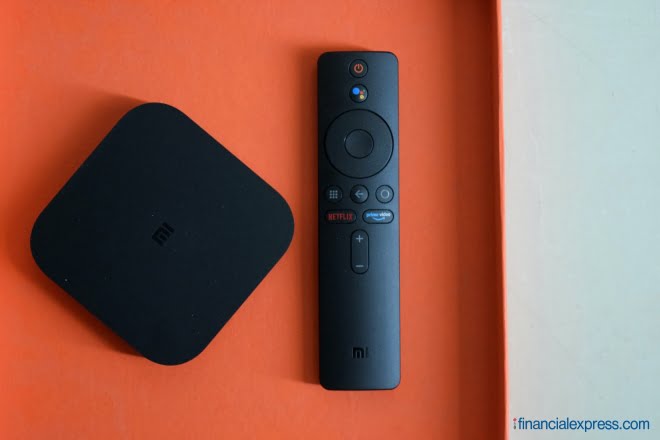
Xiaomi Mi Box 4K is a nifty little gadget that’s designed to turn your boring old HD TV into a smart TV. The Mi Box makes a lot of sense in India for two reasons. Not only does it breathe new life into your old TV, it also gives you a means to try and get acquainted with next-generation Android TV smarts, without burning a hole in your pocket. Xiaomi literally revolutionised India’s smart TV market with its affordable yet feature-packed Mi TVs. With the Mi Box 4K, it looks like it wants more people to join the smart TV bandwagon. For existing customers, the Xiaomi Mi Box 4K is your only viable option, should you be looking to invest in an official Android TV-based streaming media player in India.
The Mi Box 4K is an online streaming media player. There are broadly three types of such streaming media players in the market today. Plug and play affairs like the Amazon Fire TV Stick 4K, Google Chromecast and Airtel XStream stick. And relatively more complex-styled (but that bring added functionality) boxes like the Mi Box that you need a surface to keep on. Then there’s the Apple TV 4K (that’s also a box), that’s something else entirely when it comes to user experience and pricing.
The reason why the Mi Box doesn’t run PatchWall (too) is because Xiaomi believes Android TV is better suited for the platform, and it will also help set clear boundaries between the products that we’re dealing with. Xiaomi believes its Mi TVs cater to the most novice of users, therefore PatchWall’s content discovery smarts become crucial for that audience. A device like the Mi Box will likely be purchased by someone who may already have some idea about the kind of content they’ll like to watch, so an Android TV interface that’s based on specific apps (and not individual content) takes centre stage.
 The Mi Box 4K is an Android TV powered streaming media player. (Photo credit: Saurabh Singh/Financial Express)
The Mi Box 4K is an Android TV powered streaming media player. (Photo credit: Saurabh Singh/Financial Express)The Mi Box 4K is capable of streaming native 4K Ultra-HD content from OTT platforms like Netflix and Amazon Prime. There’s also support for HDR 10 playback. Xiaomi says the Mi Box 4K is also capable of dynamically adjusting to all types of TV screens, HD, FHD, UHD, to supposedly offer the best experience across resolutions. The Mi Box 4K supports Dolby Audio and DTS 2.0.
Under the hood, the Mi Box 4K has a quad-core processor paired with 2GB DDR3 RAM and 8GB eMMC storage. The device runs Android TV 9.0.
The boxy design allows Xiaomi to add an audio out port in the Mi Box 4K that supports both the 3.5mm and SPDIF standards.
The Mi Box 4K further comes with Chromecast built-in. It is possible to download and install apps and games on it from the Google Play Store. Plus, you can also sideload apps on the device.
Other connectivity options on the Mi Box 4K include Bluetooth 4.2 (for both audio accessories and third-party gamepads) plus 2.4GHz and 5GHz Wi-Fi.
Xiaomi Mi Box 4K India price and competition
Xiaomi has launched the Mi Box 4K in India at a price of Rs 3,499. Mi TV 4 55 owners can get it at a Rs 1,000 discount that drops the price to Rs 2,499.
Ideally, the Xiaomi Mi Box 4K has no competition. But if you’re still looking for comparisons, the device will compete with the Amazon Fire TV Stick 4K and Airtel XStream stick. You can also count the Google Chromecast in, but that won’t really be the right thing to do considering how old and basic it is.
Xiaomi Mi Box 4K setup
You must have a high-definition television with high-speed HDMI input to make use of the Mi Box 4K. Also, because the Mi Box 4K is a streaming device, it requires an active Internet connection (Wi-Fi or hotspot) to do that.
Xiaomi touts how the whole setup is simply a three step process —
- Attach the Mi Box 4K to your TV
- Connect the device to the Internet via Wi-Fi
- Start streaming
Xiaomi Mi Box 4K first impressions
 The Mi Box 4K is capable of streaming native 4K Ultra-HD content. (Photo credit: Saurabh Singh/Financial Express)
The Mi Box 4K is capable of streaming native 4K Ultra-HD content. (Photo credit: Saurabh Singh/Financial Express)The first thing you’ll notice about the Mi Box 4K is its form factor. It’s so tiny. It’s so lightweight. Like it’s not even there. Though, you’ll still have to make some space for it around your TV. Unlike the Amazon Fire TV Stick 4K or Google Chromecast, you can’t plug it directly into your TV’s HDMI port. Xiaomi bundles an HDMI cable and power adapter/cord in the box, along with a voice remote (without batteries). The Mi Box 4K is made of plastic and has two LED indicators, one on the front and another on the back — the one on the front is quite easy to miss since it’s barely visible, at least the first time when you’re setting up the whole thing.
There are four ports on the back of the Mi Box 4K — HDMI, USB 2.0, audio and power. The USB port lets you connect external storage to your Mi Box 4K so you can play local files as well as use it as an external source to run apps and games without eating up the device’s internal storage. The audio port meanwhile lets you connect external sound systems to your setup and also control the audio of your TV with the bundled voice remote, provided it has an HDMI ARC port. As for the bundled voice remote, it’s Bluetooth-enabled. While it looks a lot like the remote Xiaomi bundles with its Mi TVs, its all-round quality could surely have been a little better. It’s flimsy at best, and can’t hold a candle to what Amazon bundles with its Fire TV Stick 4K.
 Ideally, the Xiaomi Mi Box 4K has no competition. (Photo credit: Saurabh Singh/Financial Express)
Ideally, the Xiaomi Mi Box 4K has no competition. (Photo credit: Saurabh Singh/Financial Express)As far as user experience is concerned, it’s Android TV through and through which means it’s alright, not because Xiaomi intended it that way, but that’s how Google has made it at heart. While Google goes to great lengths to brag about two or three years of software support for its Android smartphones (and even tablets), Android TV is a different story altogether. Nobody clearly knows how long an Android TV-based device will be supported because unlike its smartphone OS (that’s updated every year with major updates), Google takes its own sweet time to launch Android TV updates. We know that Android TV 10 is coming, but we don’t know exactly when. Talking about Android TV 11 will just be wishful thinking at this point of time. And the software that’s available right now (Android TV 9.0) is just about as basic as basic gets. It’s okay if you’re someone who’s looking to simply plug and stream, but for those who like to tinker (Android encourages that actually), Android TV offers no satisfaction — it’s boring in fact. Even for those who will be okay with the whole experience, let me tell you, Amazon’s interface looks and feels so much better.
That may be a lot of nitpicking though, and I am aware of that. The audience that the Mi Box 4K is intended for, at least a large part of it, should be fine with the whole plug and stream experience. That’s what a streaming box is meant for, after all. And for that, the Mi Box 4K, much like any other Xiaomi product, just works.
It supports all the major OTT apps, ranging from Netflix to Amazon Prime Video to Disney+ Hotstar, plus locals like Docubay, Epic, HoiChoi, and Shemaroo. The Mi Box 4K can also let you play 5,000+ apps and games from the Google Play Store. You can pair it with third-party game pads via Bluetooth. The Mi Box 4K also comes with Chromecast built-in so casting is effortless, pleasurable actually (especially when you compare it to Amazon’s on the Fire TV Stick 4K). You can use voice commands, including firing up the Google Assistant, through the bundled remote.
Much like its Mi TVs, the Mi Box 4K also supports Google’s Data Saver functionality that’s claimed to “allow upto three times more content streaming, along with data counter for individual apps, and the ability to cast locally and wirelessly to the TV without the need for an Internet connection.”
 It supports all the major OTT apps, ranging from Netflix to Amazon Prime Video to Disney+ Hotstar. (Photo credit: Saurabh Singh/Financial Express)
It supports all the major OTT apps, ranging from Netflix to Amazon Prime Video to Disney+ Hotstar. (Photo credit: Saurabh Singh/Financial Express)As for streaming quality, it’s quite good. Especially for the price. Barring some minor hiccups here and there, the Mi Box 4K does well delivering native 4K HDR (@60fps) content the way it was intended. Though that might still be an overkill since chances are buyers who get the Mi Box 4K may not necessarily have a 4K HDR TV setup at home. Games like Asphalt and Badlands also work well enough, which is an added bonus.
The Mi Box 4K may not kill the Amazon Fire TV Stick 4K in terms of pure specs and features, plus user experience as well, but it more than compensates for all those things in pricing. Xiaomi’s pricing undercuts Amazon’s while bringing a lot of similar functionality including a voice remote to the table. Needless to say, it looks like another winner from Xiaomi. Watch this space for our full review of the Xiaomi Mi Box 4K in the days to come.
source: financialexpress










